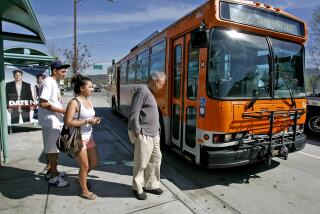It’s a Hard Road for Those Stranded by Buses
- Share via
It’s been 13 days without the buses and, to Eva Diaz, who works at a food-packing firm, it’s humiliating what she has become: a ride beggar. Eric Guzman has had to beg too, pleading with his boss not to fire him after he was two hours late to his downtown Fashion District job. And Roberto Marquez, a Pacoima day laborer, was passed over for two jobs because there was no way he could make it to Simi Valley and Redondo Beach.
For the thousands of laborers who depend for their livelihood on commuting on buses and trains, work-related stress begins before they even clock in at their jobs.
Some said they’re embarrassed at having to repeatedly ask friends and neighbors for rides. Others bicycle or walk as long as two hours each way to get to their jobs on time.
“I even feel like I’m getting sick, with them saying the strike is about to end, and then the next day, no, it’s still going on,” said Diaz, 56. “They make us live on illusions.”
Day laborers say they often have to pass on better-paying jobs because they can’t get to the work, and some say that more day workers are on the streets because they don’t have transportation to their usual places of employment.
To maintain her pride, Diaz, who lives in Sylmar and works in Sun Valley, said she offers the 80-year-old neighbor who is driving her to work $10 for each ride. Yet she still worries about being late getting to work and because her neighbor’s eyesight is waning.
“I think she’s a good driver actually, but sometimes she lets out a little scream and says, ‘Ay, I didn’t see that car!’ ”
Every day, Diaz said asking for a ride gets harder. She shows her appreciation by buying her neighbor such gifts as Mexican sweet bread or a bathrobe.
On the strike’s first day, Guzman said, he had to persuade his boss not to fire him from his job in the Fashion District. With no bus transportation, Guzman was forced to walk about 50 blocks from his home near Western Avenue and Olympic Boulevard to his job at a bead store--arriving late.
Since then, he said, he has factored the hourlong trek into his routine, carrying a water bottle in the heat.
Walking is also the only option for Marquez, who travels two hours from his home in a Pacoima garage to a Sylmar street corner to wait under the hot sun with other day laborers for work painting homes, setting tiles or laying cement.
When he does get a job, the 42-year-old immigrant said he works hard because he knows if an employer appreciates the job he does, he’ll get more plum jales, or assignments, in the future.
“They remember you if you do good work and if you put a lot of ganas [effort] into what you do,” Marquez said.
But the strike has thrown a wrench into the system. Like other laborers, Marquez can now take a job only if the employer provides round-trip transportation.
This week alone, he said, he’s had to decline work in Simi Valley and Redondo Beach because he had no way to get there.
He said he hopes, but isn’t optimistic, that those employers, impressed with his work ethic, will wait for him.
But he fears “they’ll find someone else. And if that person does a good job, they may never call you again.”
Marquez is not alone in missing out on more lucrative work.
“I’ve lost about six or seven jobs because of the strike,” said Sotero Sanchez, 44, an immigrant from the Mexican state of Puebla, as he stood across from a U-Haul depot in Van Nuys. “Someone called me from Pasadena, but what can I do?”
Every morning, Sanchez walks 90 minutes to the corner of Saticoy Street and Van Nuys Boulevard from the one-bedroom apartment in San Fernando he shares with his wife and 14-year-old daughter.
The jobs he gets helping people move can sometimes net a bit of generosity from homeowners: a small television or clothes for his family.
But the better-paying jobs usually come after you’ve made that first good impression, Sanchez said. And those are the jobs that he can’t take, because he has no car and the buses aren’t running.
For Marquez, the strike has also meant missing English classes at San Fernando High School, which are important to him.
“What you get from a classroom -- no one can take that away,” Marquez said.
Clutching a beaten-up “Seek & Circle” word puzzle book, Marquez said he had completed only one year of school in Mexico, but always liked to read.
But doing physical work and then having to walk two hours back home has sapped his drive to go to class, he said.
This saddens him, he said, because he came to this country in large part to make money so his son could go to college in Mexico City.
“I came here because I believe if I make sacrifices, big or small, my son can grow as a human and find his path in life easier than I did,” Marquez said. “But this strike has taken away my desire to study, which is sad.”
For Sofia Hernandez, a long commute was always part of her daily routine to get to her job as a maid in Pacific Palisades. The 45-year-old Boyle Heights woman would spend 90 minutes and take three MTA buses to get to work by 9 a.m.
Now she walks and relies on buses run by other transit agencies.
Her patchwork, three-hour commute starts now with a frequently packed Montebello municipal bus, which she takes to 3rd and Spring streets downtown.
If the bus is too crowded, she pays a stranger $2 to take her. Often, she said, “there’s eight of us packed in there.”
She then walks a few blocks to Temple Street to catch a Santa Monica bus to 4th Street and Broadway in Santa Monica. From there she takes another Santa Monica bus to Chautauqua and Sunset boulevards. She walks the last two miles to the house on Spoleto Drive.
In the evening, she reverses her commute to get back to Boyle Heights.
“By the time I get home, my feet hurt,” she said.
For her part, Diaz said she is ready to vent her anger about the strike. When will it end? How close are the two sides? she asks.
“I’ve heard that some people have started protesting. If there’s a protest, I would go,” Diaz said, “as long as somebody could give me a ride.”
More to Read
Sign up for Essential California
The most important California stories and recommendations in your inbox every morning.
You may occasionally receive promotional content from the Los Angeles Times.











